window FIAT STILO 2006 1.G Service Manual
[x] Cancel search | Manufacturer: FIAT, Model Year: 2006, Model line: STILO, Model: FIAT STILO 2006 1.GPages: 274, PDF Size: 4.76 MB
Page 204 of 274
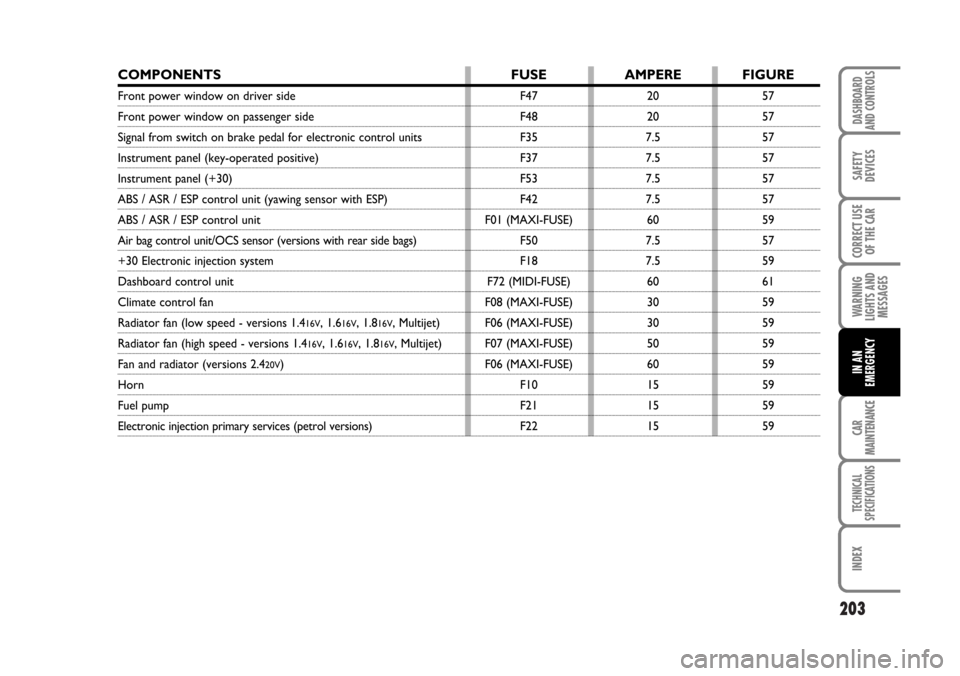
203
WARNING
LIGHTS AND
MESSAGES
CAR
MAINTENANCE
TECHNICAL
SPECIFICATIONS
INDEX
DASHBOARD
AND CONTROLS
SAFETY
DEVICES
CORRECT USE
OF THE CAR
IN AN
EMERGENCY
COMPONENTS
Front power window on driver side
Front power window on passenger side
Signal from switch on brake pedal for electronic control units
Instrument panel (key-operated positive)
Instrument panel (+30)
ABS / ASR / ESP control unit (yawing sensor with ESP)
ABS / ASR / ESP control unit
Air bag control unit/OCS sensor (versions with rear side bags)
+30 Electronic injection system
Dashboard control unit
Climate control fan
Radiator fan (low speed - versions 1.416V, 1.616V, 1.816V, Multijet)
Radiator fan (high speed - versions 1.416V, 1.616V, 1.816V, Multijet)
Fan and radiator (versions 2.420V)
Horn
Fuel pump
Electronic injection primary services (petrol versions)
FUSE
F47
F48
F35
F37
F53
F42
F01 (MAXI-FUSE)
F50
F18
F72 (MIDI-FUSE)
F08 (MAXI-FUSE)
F06 (MAXI-FUSE)
F07 (MAXI-FUSE)
F06 (MAXI-FUSE)
F10
F21
F22
AMPERE
20
20
7.5
7.5
7.5
7.5
60
7.5
7.5
60
30
30
50
60
15
15
15
FIGURE
57
57
57
57
57
57
59
57
59
61
59
59
59
59
59
59
59
Page 205 of 274
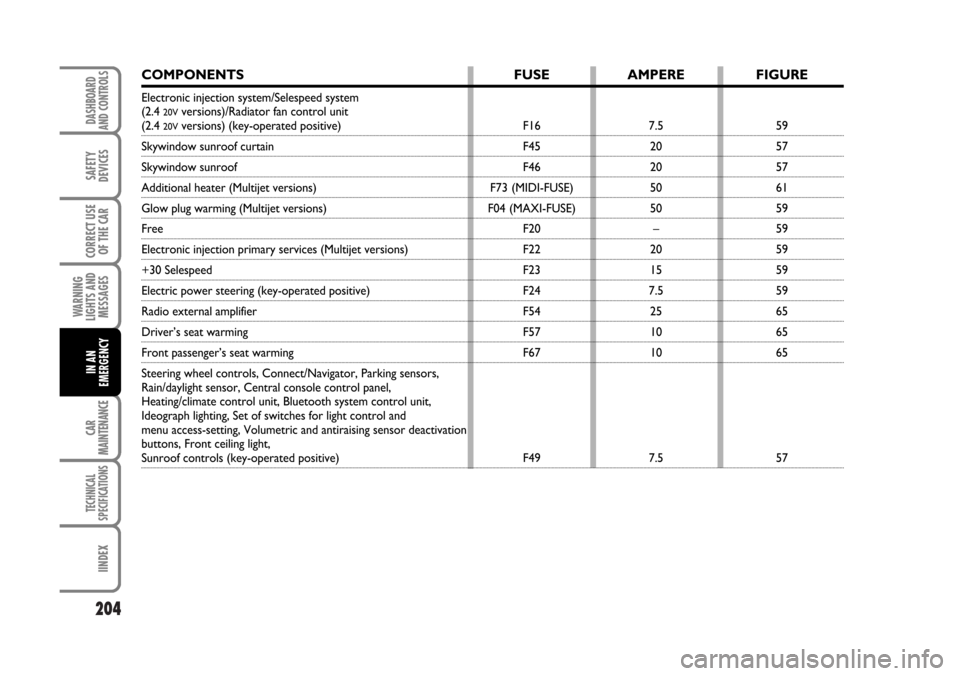
204
WARNING
LIGHTS AND
MESSAGES
CAR
MAINTENANCE
TECHNICAL
SPECIFICATIONS
IINDEX
DASHBOARD
AND CONTROLS
SAFETY
DEVICES
CORRECT USE
OF THE CAR
IN AN
EMERGENCY
COMPONENTS
Electronic injection system/Selespeed system
(2.4 20Vversions)/Radiator fan control unit(2.4 20Vversions) (key-operated positive)
Skywindow sunroof curtain
Skywindow sunroof
Additional heater (Multijet versions)
Glow plug warming (Multijet versions)
Free
Electronic injection primary services (Multijet versions)
+30 Selespeed
Electric power steering (key-operated positive)
Radio external amplifier
Driver’s seat warming
Front passenger’s seat warming
Steering wheel controls, Connect/Navigator, Parking sensors,
Rain/daylight sensor, Central console control panel,
Heating/climate control unit, Bluetooth system control unit,
Ideograph lighting, Set of switches for light control and
menu access-setting, Volumetric and antiraising sensor deactivation
buttons, Front ceiling light,
Sunroof controls (key-operated positive)
FUSE
F16
F45
F46
F73 (MIDI-FUSE)
F04 (MAXI-FUSE)
F20
F22
F23
F24
F54
F57
F67
F49
AMPERE
7.5
20
20
50
50
–
20
15
7.5
25
10
10
7.5
FIGURE
59
57
57
61
59
59
59
59
59
65
65
65
57
Page 210 of 274
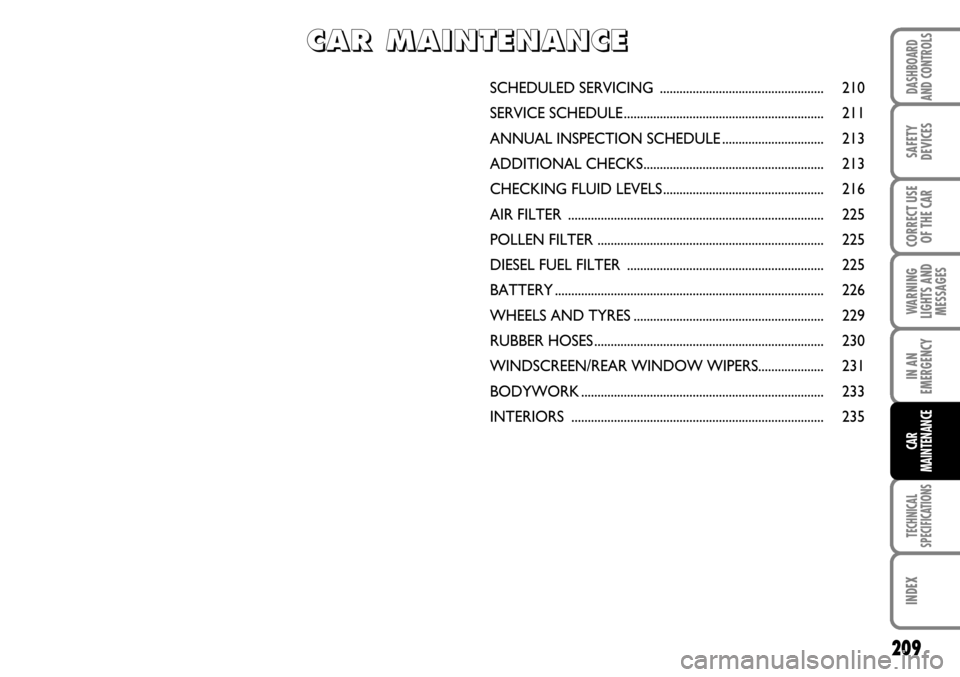
209
WARNING
LIGHTS AND
MESSAGES
TECHNICAL
SPECIFICATIONS
INDEX
DASHBOARD
AND CONTROLS
SAFETY
DEVICES
CORRECT USE
OF THE CAR
IN AN
EMERGENCY
CAR
MAINTENANCE
SCHEDULED SERVICING .................................................. 210
SERVICE SCHEDULE ............................................................. 211
ANNUAL INSPECTION SCHEDULE ............................... 213
ADDITIONAL CHECKS....................................................... 213
CHECKING FLUID LEVELS ................................................. 216
AIR FILTER .............................................................................. 225
POLLEN FILTER ..................................................................... 225
DIESEL FUEL FILTER ............................................................ 225
BATTERY .................................................................................. 226
WHEELS AND TYRES .......................................................... 229
RUBBER HOSES ...................................................................... 230
WINDSCREEN/REAR WINDOW WIPERS.................... 231
BODYWORK .......................................................................... 233
INTERIORS ............................................................................. 235
C C C C
A A A A
R R R R
M M M M
A A A A
I I I I
N N N N
T T T T
E E E E
N N N N
A A A A
N N N N
C C C C
E E E E
Page 212 of 274
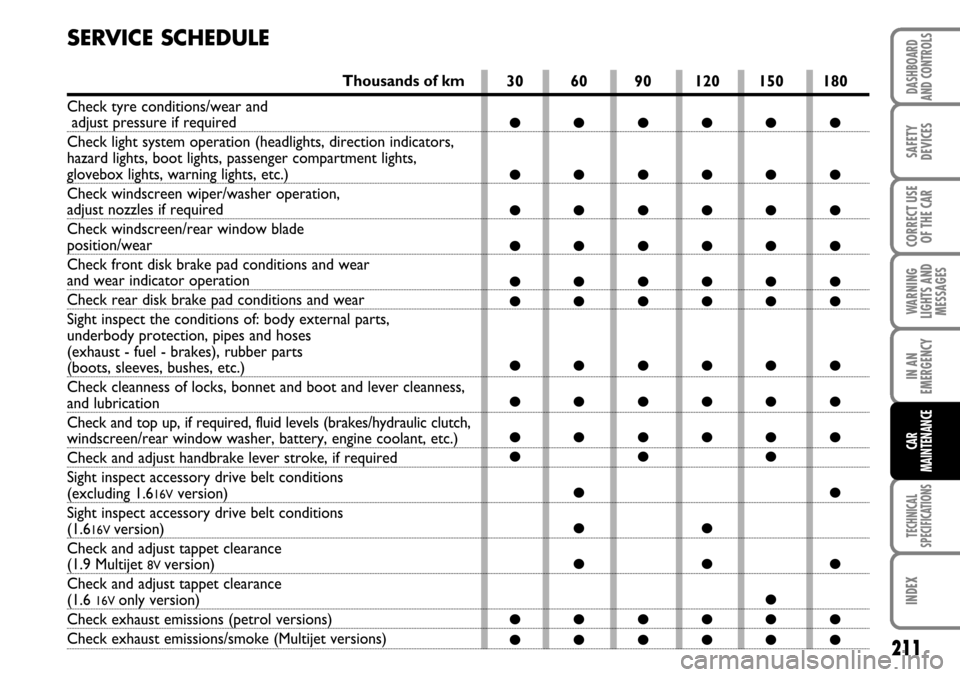
211
WARNING
LIGHTS AND
MESSAGES
TECHNICAL
SPECIFICATIONS
INDEX
DASHBOARD
AND CONTROLS
SAFETY
DEVICES
CORRECT USE
OF THE CAR
IN AN
EMERGENCY
CAR
MAINTENANCE
SERVICE SCHEDULE
30 60 90 120 150 180
●●●●●●
●●●●●●
●●●●●●
●●●●●●
●●●●●●
●●●●●●
●●●●●●
●●●●●●
●●●●●●
●●●
●●
●●
●●●
●
●●●●●●
●●●●●●
Thousands of km
Check tyre conditions/wear and
adjust pressure if required
Check light system operation (headlights, direction indicators,
hazard lights, boot lights, passenger compartment lights,
glovebox lights, warning lights, etc.)
Check windscreen wiper/washer operation,
adjust nozzles if required
Check windscreen/rear window blade
position/wear
Check front disk brake pad conditions and wear
and wear indicator operation
Check rear disk brake pad conditions and wear
Sight inspect the conditions of: body external parts,
underbody protection, pipes and hoses
(exhaust - fuel - brakes), rubber parts
(boots, sleeves, bushes, etc.)
Check cleanness of locks, bonnet and boot and lever cleanness,
and lubrication
Check and top up, if required, fluid levels (brakes/hydraulic clutch,
windscreen/rear window washer, battery, engine coolant, etc.)
Check and adjust handbrake lever stroke, if required
Sight inspect accessory drive belt conditions
(excluding 1.616Vversion)
Sight inspect accessory drive belt conditions
(1.616V version)
Check and adjust tappet clearance
(1.9 Multijet 8V version)
Check and adjust tappet clearance
(1.6 16V only version)
Check exhaust emissions (petrol versions)
Check exhaust emissions/smoke (Multijet versions)
Page 214 of 274
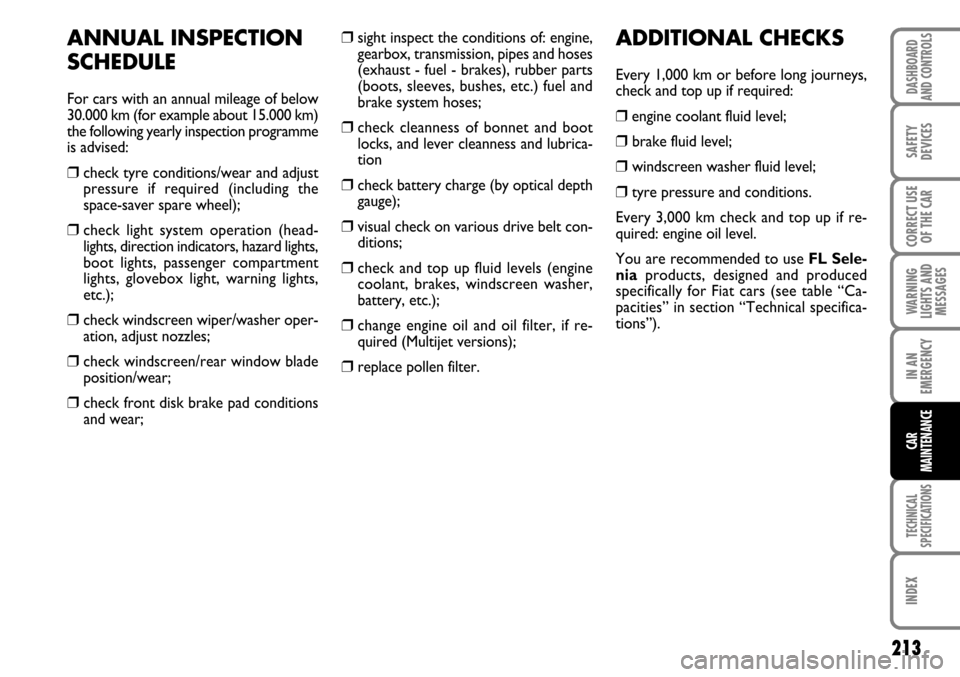
213
WARNING
LIGHTS AND
MESSAGES
TECHNICAL
SPECIFICATIONS
INDEX
DASHBOARD
AND CONTROLS
SAFETY
DEVICES
CORRECT USE
OF THE CAR
IN AN
EMERGENCY
CAR
MAINTENANCE
ANNUAL INSPECTION
SCHEDULE
For cars with an annual mileage of below
30.000 km (for example about 15.000 km)
the following yearly inspection programme
is advised:
❒check tyre conditions/wear and adjust
pressure if required (including the
space-saver spare wheel);
❒check light system operation (head-
lights, direction indicators, hazard lights,
boot lights, passenger compartment
lights, glovebox light, warning lights,
etc.);
❒check windscreen wiper/washer oper-
ation, adjust nozzles;
❒check windscreen/rear window blade
position/wear;
❒ check front disk brake pad conditions
and wear;
❒sight inspect the conditions of: engine,
gearbox, transmission, pipes and hoses
(exhaust - fuel - brakes), rubber parts
(boots, sleeves, bushes, etc.) fuel and
brake system hoses;
❒check cleanness of bonnet and boot
locks, and lever cleanness and lubrica-
tion
❒check battery charge (by optical depth
gauge);
❒visual check on various drive belt con-
ditions;
❒check and top up fluid levels (engine
coolant, brakes, windscreen washer,
battery, etc.);
❒change engine oil and oil filter, if re-
quired (Multijet versions);
❒replace pollen filter.
ADDITIONAL CHECKS
Every 1,000 km or before long journeys,
check and top up if required:
❒engine coolant fluid level;
❒ brake fluid level;
❒ windscreen washer fluid level;
❒tyre pressure and conditions.
Every 3,000 km check and top up if re-
quired: engine oil level.
You are recommended to use FL Sele-
niaproducts, designed and produced
specifically for Fiat cars (see table “Ca-
pacities” in section “Technical specifica-
tions”).
Page 217 of 274
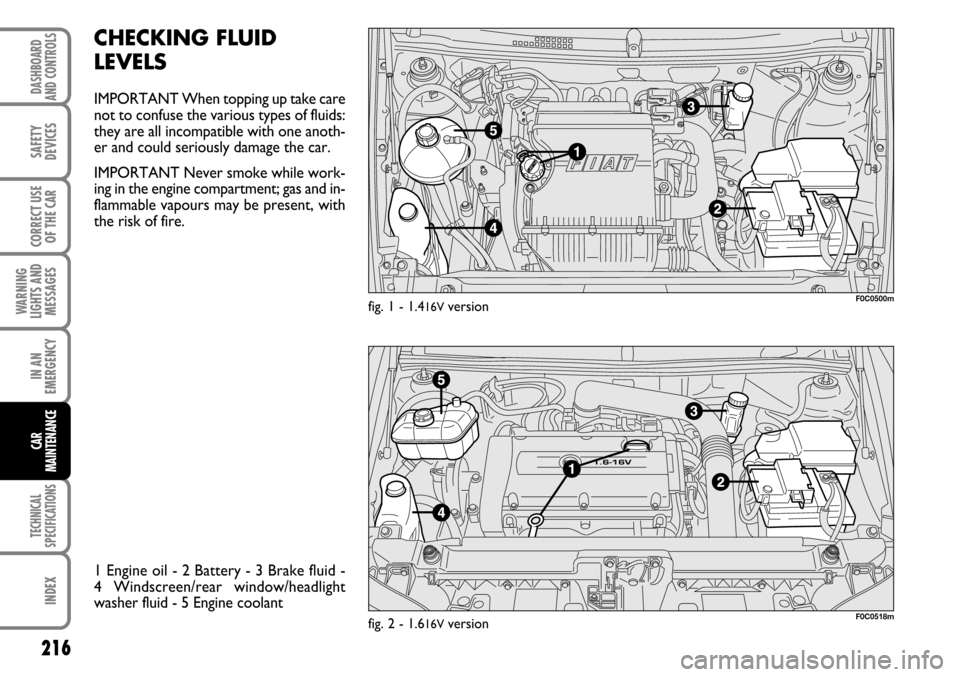
216
WARNING
LIGHTS AND
MESSAGES
TECHNICAL
SPECIFICATIONS
INDEX
DASHBOARD
AND CONTROLS
SAFETY
DEVICES
CORRECT USE
OF THE CAR
IN AN
EMERGENCY
CAR
MAINTENANCE
CHECKING FLUID
LEVELS
IMPORTANT When topping up take care
not to confuse the various types of fluids:
they are all incompatible with one anoth-
er and could seriously damage the car.
IMPORTANT Never smoke while work-
ing in the engine compartment; gas and in-
flammable vapours may be present, with
the risk of fire.
1 Engine oil - 2 Battery - 3 Brake fluid -
4 Windscreen/rear window/headlight
washer fluid - 5 Engine coolant
F0C0500mfig. 1 - 1.416V version
F0C0518mfig. 2 - 1.616V version
Page 218 of 274
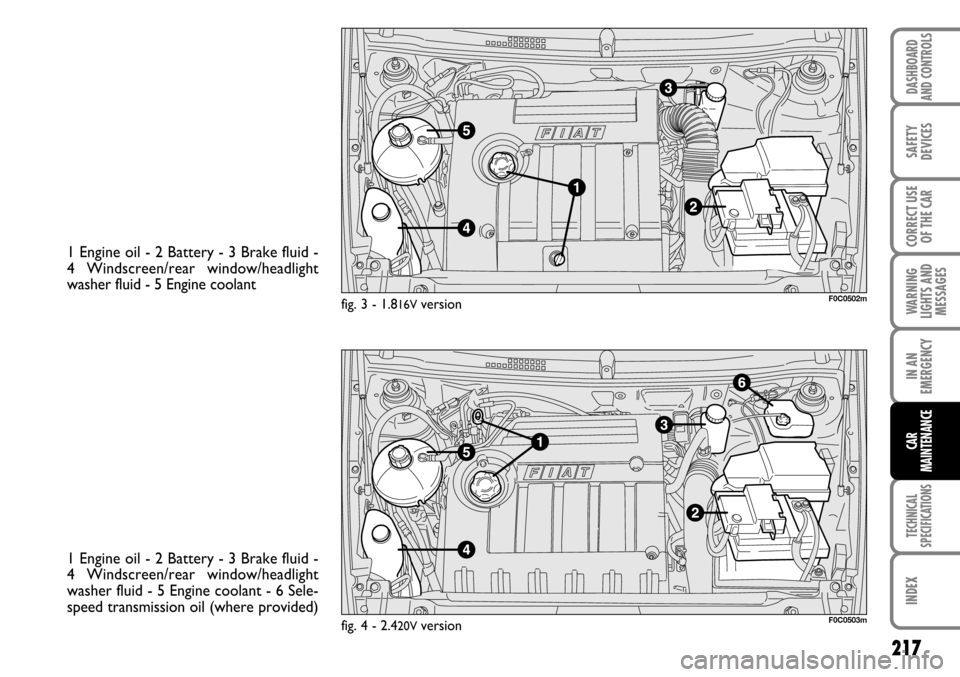
217
WARNING
LIGHTS AND
MESSAGES
TECHNICAL
SPECIFICATIONS
INDEX
DASHBOARD
AND CONTROLS
SAFETY
DEVICES
CORRECT USE
OF THE CAR
IN AN
EMERGENCY
CAR
MAINTENANCE
1 Engine oil - 2 Battery - 3 Brake fluid -
4 Windscreen/rear window/headlight
washer fluid - 5 Engine coolant - 6 Sele-
speed transmission oil (where provided)
fig. 3 - 1.816V version
fig. 4 - 2.4
20V version
1 Engine oil - 2 Battery - 3 Brake fluid -
4 Windscreen/rear window/headlight
washer fluid - 5 Engine coolant
F0C0502m
F0C0503m
Page 219 of 274
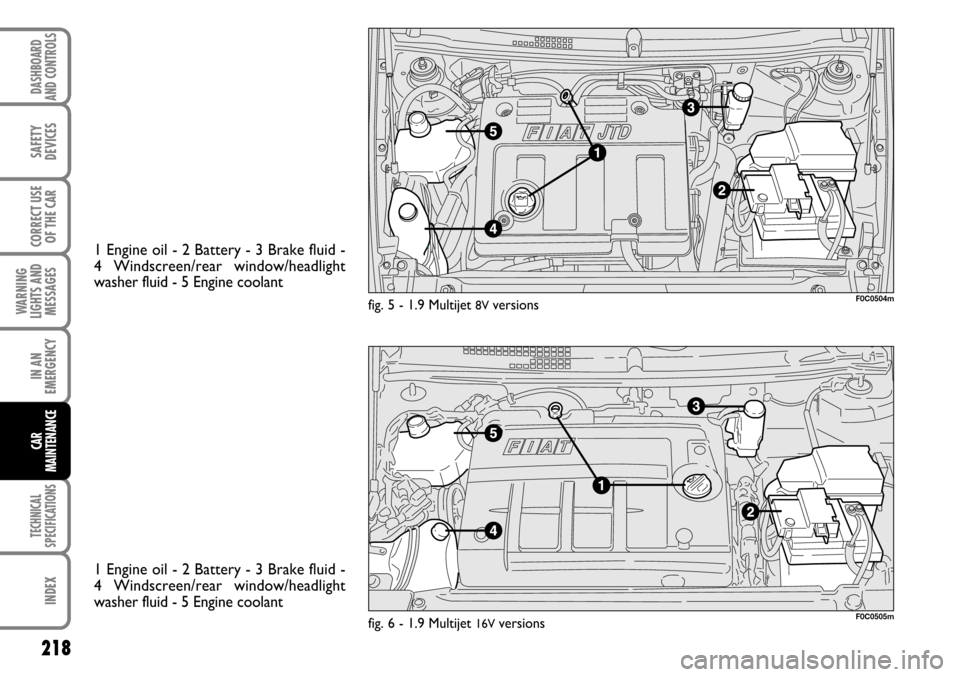
218
WARNING
LIGHTS AND
MESSAGES
TECHNICAL
SPECIFICATIONS
INDEX
DASHBOARD
AND CONTROLS
SAFETY
DEVICES
CORRECT USE
OF THE CAR
IN AN
EMERGENCY
CAR
MAINTENANCE
1 Engine oil - 2 Battery - 3 Brake fluid -
4 Windscreen/rear window/headlight
washer fluid - 5 Engine coolant
1 Engine oil - 2 Battery - 3 Brake fluid -
4 Windscreen/rear window/headlight
washer fluid - 5 Engine coolant
fig. 6 - 1.9 Multijet 16V versions
F0C0504mfig. 5 - 1.9 Multijet 8V versions
F0C0505m
Page 224 of 274
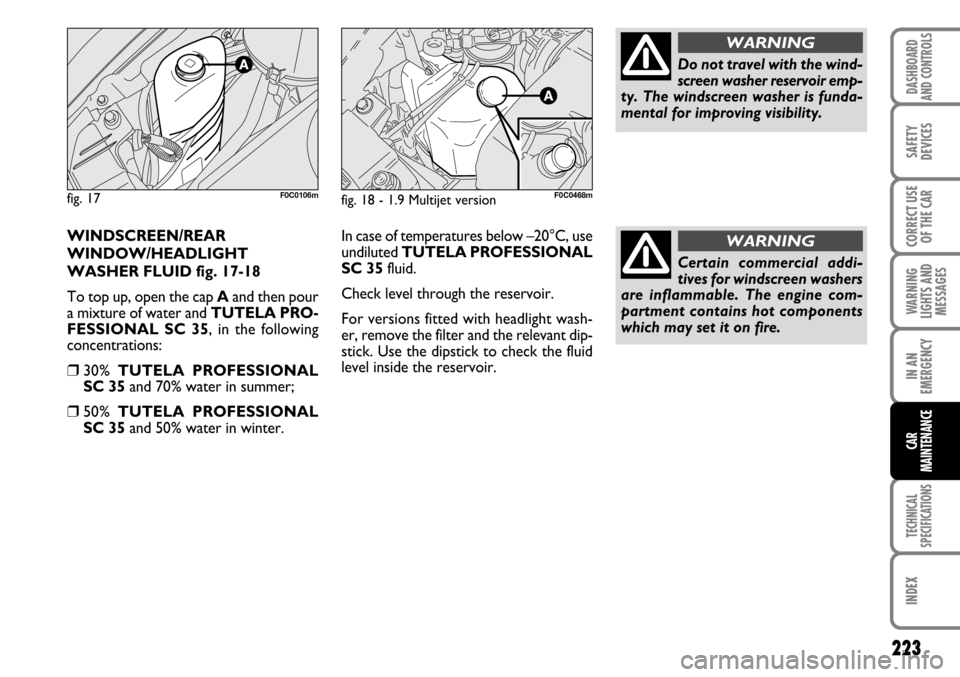
223
WARNING
LIGHTS AND
MESSAGES
TECHNICAL
SPECIFICATIONS
INDEX
DASHBOARD
AND CONTROLS
SAFETY
DEVICES
CORRECT USE
OF THE CAR
IN AN
EMERGENCY
CAR
MAINTENANCE
WINDSCREEN/REAR
WINDOW/HEADLIGHT
WASHER FLUID fig. 17-18
To top up, open the cap Aand then pour
a mixture of water and TUTELA PRO-
FESSIONAL SC 35, in the following
concentrations:
❒30% TUTELA PROFESSIONAL
SC 35and 70% water in summer;
❒50% TUTELA PROFESSIONAL
SC 35and 50% water in winter.
fig. 17F0C0106mfig. 18 - 1.9 Multijet version F0C0468m
Do not travel with the wind-
screen washer reservoir emp-
ty. The windscreen washer is funda-
mental for improving visibility.
WARNING
Certain commercial addi-
tives for windscreen washers
are inflammable. The engine com-
partment contains hot components
which may set it on fire.
WARNINGIn case of temperatures below –20°C, use
undiluted TUTELA PROFESSIONAL
SC 35 fluid.
Check level through the reservoir.
For versions fitted with headlight wash-
er, remove the filter and the relevant dip-
stick. Use the dipstick to check the fluid
level inside the reservoir.
Page 232 of 274
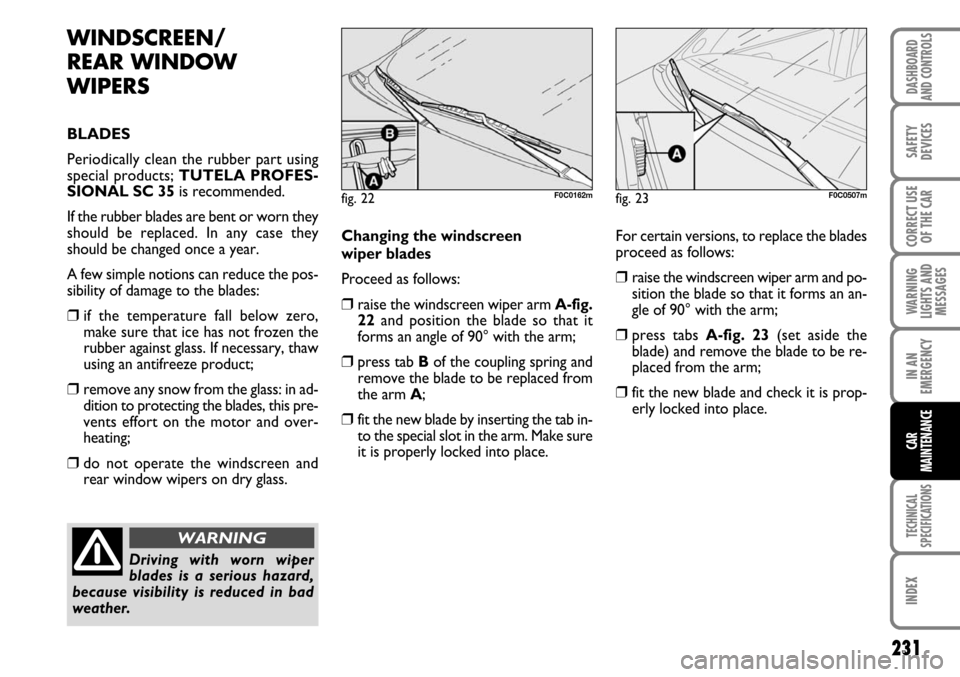
231
WARNING
LIGHTS AND
MESSAGES
TECHNICAL
SPECIFICATIONS
INDEX
DASHBOARD
AND CONTROLS
SAFETY
DEVICES
CORRECT USE
OF THE CAR
IN AN
EMERGENCY
CAR
MAINTENANCE
WINDSCREEN/
REAR WINDOW
WIPERS
BLADES
Periodically clean the rubber part using
special products; TUTELA PROFES-
SIONAL SC 35is recommended.
If the rubber blades are bent or worn they
should be replaced. In any case they
should be changed once a year.
A few simple notions can reduce the pos-
sibility of damage to the blades:
❒ if the temperature fall below zero,
make sure that ice has not frozen the
rubber against glass. If necessary, thaw
using an antifreeze product;
❒remove any snow from the glass: in ad-
dition to protecting the blades, this pre-
vents effort on the motor and over-
heating;
❒do not operate the windscreen and
rear window wipers on dry glass.Changing the windscreen
wiper blades
Proceed as follows:
❒raise the windscreen wiper arm A-fig.
22and position the blade so that it
forms an angle of 90° with the arm;
❒press tab Bof the coupling spring and
remove the blade to be replaced from
the arm A;
❒fit the new blade by inserting the tab in-
to the special slot in the arm. Make sure
it is properly locked into place.For certain versions, to replace the blades
proceed as follows:
❒raise the windscreen wiper arm and po-
sition the blade so that it forms an an-
gle of 90° with the arm;
❒press tabs A-fig. 23(set aside the
blade) and remove the blade to be re-
placed from the arm;
❒fit the new blade and check it is prop-
erly locked into place.
Driving with worn wiper
blades is a serious hazard,
because visibility is reduced in bad
weather.
WARNING
fig. 22F0C0162mfig. 23F0C0507m